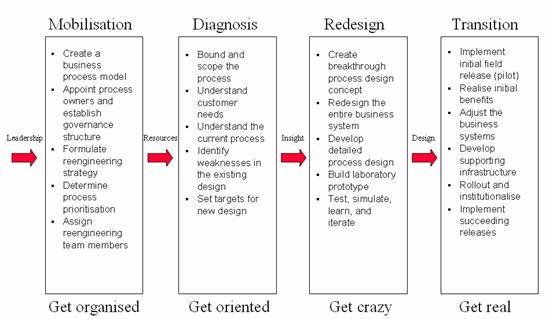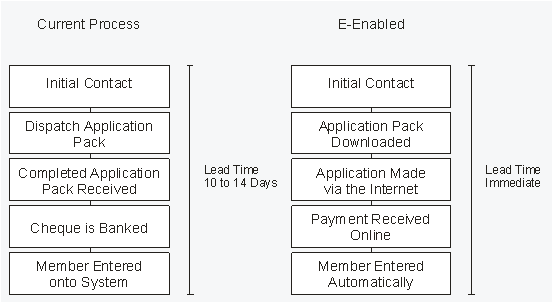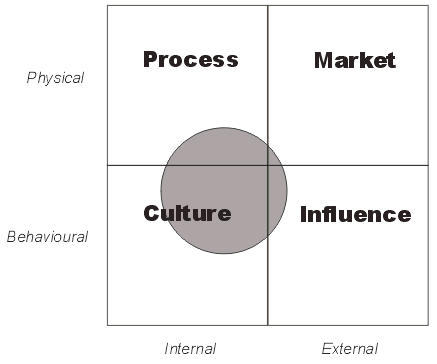To explore the concept of business process reengineering the Author will create a fictitious origination:
This organisation will be an accrediting Society that operates on a paper-based system to process their memberships and payments for membership and renewals are made via cheque payments
Table 1 identifies the changes in the business processes.
Table 1 Affected business processes
| Business Processes |
| Communicating with Customers |
|
|
|
|
|
| Receiving Payment |
How are these business processes affected?
Currently, acquiring membership, renewing membership, queries, and complaints are all dealt with in the following 4 channels of communication:
- Postal
- Telephone
- Fax
- Face to face
“Face to face” refers to Members that acquire membership at exhibitions. Prospective members that are unable to attend exhibitions use the telephone to acquire membership.
The introduction of Information Technology to the membership process, shall introduce two new channels of communications. These include the following:
- Internet Web Site (managing membership & payment)
Who is affected in the Society?
Fig 1 Fictitious Society Organisational Structure
Employees in the IT and Certificate & Training Departments are affected. They will be expected to reply to email queries concerning their area of expertise. For example, if a Member sent a technical query it would be sent directly to the IT Department who would send an appropriate response back to the Member via email. An email address can be set up as: technical@example.org.uk, which would be advertised on the website. This will ensure that technical emails are directed to the IT department.
Business Process Reengineering
With the introduction of ICT, the following business processes are affected:
Table 2 Business Processes Reengineering
| Process | From | To |
| Communicating with Members | Costly and slow | Inexpensive and quick |
| Administration of Members | Time consuming and opaque | Succinct and transparent |
| Receiving Payment | Gradual | Immediate |
How you can reengineer?
To reengineer a business process is in its simplest terms is to redesign a business process. “Process redesign is the start of reengineering” ( University of Hong Kong , 2001) . To put this into context with BSCCP, we may examine their payment process to see how it can be re-designed to improve it. The use of Information systems in this instance has the potential to radically redesign this process. “Information systems are the fundamental ingredient of redesigned business processes.” (Butler Cox Foundation, 1991)
The Massachusetts Institute of Technology’s research program ‘Management in the 1990s’ revealed that successful organisations were using “IT systems in ways which were more advanced than traditional automation of clerical and operational tasks” (Davenport and Short, 1990)
Fig 2 the Process for Business Reengineering
( University of Hong Kong, 2001)
Table 3 Business Processes Prioritised
| Business Processes Prioritised | Reason |
| Receiving Payment | As cash flow is primarily the chief objective it is therefore priority. |
| Administration of Members | The receiving payment process relies on the Administration of members to make it possible. |
| Communicating with Members | Communicating with members is important but not as important as the other two processes in delivering results. |
Justifying the Reasons for Change?
A majority of businesses on the Internet failed during the recent dot.com boom and bust period because “they focused on technology without learning about the industry they entered.” (Tuccillo, 2002). E-enabling would suggest that the Society’s business processes (see Table 1) would have to be improved by, improving the exchange of critical knowledge, and streamlining communications.
Membership process through the website
Fig 3 Membership process through the web site
The membership process can be improved by E-enabling the Society’s membership process. Membership to the society can be made, renewed and paid for via an internet website. E-enabling can reduce the time it takes to bring money in, and reduce administration costs which will save the Society money and allow the to process more members.
Strategies Adopted In Response to the Need for Change
The need for vision
Fig. 4 Change Management Matrix
(Sparrow & Marchinghton, 1998)
There is extensive confusion as to what corporate culture actually means. The culture of an organisation is a set of “unwritten rules” dictating behaviour. Culture develops over time with the customs of a organisation. As the organisation ages it becomes more and more difficult to alter.
Management may have a set of protocols for employees to adhere to perform business processes. The way a task is actually carried out depends namely on the culture. The culture of the organisation can strongly resist changing as employees become too familiar with the current way of doing things.
“Culture is the integrated pattern of human behaviour that includes thought, speech, action, and artefacts and depends on man’s capacity for learning and transmitting knowledge to succeeding generations.”(Webster’s New Collegiate Dictionary)
Figure 20 shows the importance of Culture and its relationship to Managing Change. Leaders that drastically challenge Company Culture often encounter resistance.
Creating the right culture
Communication
Typically there are four different types of Communication networks which exist in organisations. These include:
- Hierarchy – This network involves the official roles and the titles that are held by Members within the Organisation.
- Expert Communication – This network involves the interests and skills which are grouped amongst the Organisation Specialisms.
- Influential – Typically, this refers to those who wield power and authority within the Company through politics, rank, skills or family relationships.
- Friendship – This network provides for seeking of information needed to help one another. This network involves family, friends and supporters within the Company.
Team-building for change
Tuckman’s (1977) Group Stage
- Forming – This stage involves the forming of a group structure.
- Storming – This stage concerns itself with the development and focus on personal relationships within the group. Confrontations can involve who is responsible for what.
- Norming – This stage involves the ‘settling’ down of the group. It allows the individuals to feel a sense of ‘belonging’, rather the merely ‘being’ in the group. This stage involves the giving and receiving of information and general overview of how things are going.
- Performing – This stage allows the group members to achieve interdependence which means that they have achieved more from working together than they would have as individuals.
Team building reflects commitment to change. It is important to realise the distinction between working in teams and team building itself. The responsibility for a team does not always include the commitment needed for the investment into team building. In reality, team building can be a slow process which takes effect over many months and years.



